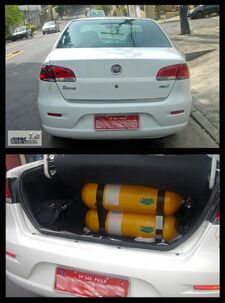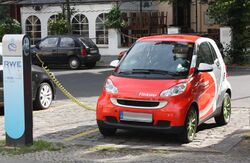Bi-fuel vehicle
Topic: Engineering
 From HandWiki - Reading time: 7 min
From HandWiki - Reading time: 7 min

Bi-fuel vehicles are vehicles with multifuel engines capable of running on two fuels. The two fuels are stored in separate tanks and the engine is able to run on one fuel at a time. On internal combustion engines, a bi-fuel engine typically burns gasoline and a volatile alternate fuel such as natural gas (CNG), LPG, or hydrogen.[1] Bi-fuel vehicles have the capability to switch back and forth from the gasoline to the other fuel, manually or automatically.[2][3][4][5] A related concept is the duel-fuel vehicle which must burn both fuels in combination. Diesel engines converted to use gaseous fuels fall into this class due to the different ignition system.
The most common technology and alternate fuel available in the market for bi-fuel gasoline cars is Autogas (LPG), followed by natural gas (CNG),[6] and it is used mainly in Europe. Poland, the Netherlands and the Baltic states have many cars running with LPG. Italy currently has the largest number of CNG vehicles, followed by Sweden. They are also used in South America, where these vehicles are mainly used as taxicabs in main cities of Brazil and Argentina . Normally, standard gasoline vehicles are retrofitted in specialized shops, which involve installing the gas cylinder in the trunk and the LPG or CNG injection system and electronics. The conversion is possible because the gases can use the spark-ignition of a gasoline engine.[7]
Diesel conversions
A Diesel engine is a compression ignition engine and does not have a spark plug. To operate a diesel engine with an alternate combustible fuel source such as natural gas, a Dual-Fuel system used with natural gas as the main fuel while diesel fuel is used for the ignition of the gas/air mixture inside the cylinder. In other words, a portion of diesel is injected at the end of the compression stroke, thereby maintaining the original diesel operation principle. (Running gas-only is possible, but requires more extensive modification.)[8][9]
Dual-fuel operation in this case means the engine uses two fuels (gas and diesel) at the same time, as opposed to Bi-Fuel which would mean the engine could have the option of using either fuel separately.
There usually two type of conversions – low speed (below 1000 RPM) and high speed (between 1200 and 1800 RPM).
Low and middle speed conversion
Gas is injected into the cylinder inlet manifold by individual gas electromagnetic valves installed as close to the intake valves as possible. The valves are separately timed and controlled by injection control unit. This system interrupts the gas supply to the cylinder during the long overlap of the intake and exhaust valves (just typical for slow-speed and medium-speed engines – within the valve overlap cylinder scavenging is performed). This avoids substantial gas losses and prevents dangerous gas flow to the exhaust manifold.
- This conversion is adjusted for low speed engines up to 1000 RPM.
- System for conversion of industrial diesel engine to Bi-fuel operation by substitution of 70–90% natural gas for diesel or HFO.
- Gas is injected directly before intake valve by high speed electromagnetic injector, one or two injector per each cylinder.
High-speed conversion
Gas is mixed with air by a common mixer installed before turbocharger(s). Gas flow is controlled by a throttle valve, which is electronically operated by the special control system according to the required engine output and speed. In order to avoid knocking of the engine, knocking detector/controller is installed, thus enabling engine operation at the most efficient gas/diesel ratio.[10]
- Suitable for all High-Speed engines, 1200–1800 RPM.
- System for conversion of industrial diesel engine to Bi-fuel operation by substitution of 50–80% natural gas for diesel.
- Gas and air are blended behind air filter before turbocharger by central mixer.
Conversion features and benefits
Benefits relating to conversion to bi-fuel vehicles include savings on operation costs, little to no engine modification of the existing vehicle and non-derated output power. Other benefits also include emissions reduction (due to different C/H atom ratio) and fuel flexibility.
Gas types used
It is common to use CNG (Compressed Natural Gas) or LNG (Liquid Natural Gas) for bi-fuel operations. Both are also mostly used for generator sets conversions, because the engine does not lose the output power.
In recent years biogas is being used. The biogas composition and calorific value must be known in order to evaluate if the particular biogas type is suitable. Calorific value may be an issue as biogas is derived from different sources and there is low calorific value in many cases. You can imagine you have to inject sufficient volume of gas into the cylinder to substitute diesel oil (or, better to say, substitute energy delivered by diesel oil). If the calorific value (energy) of the biogas was very low, there is a need to inject really big volume of biogas into the cylinder, which might be technically impossible. Additionally, the composition of the biogas has to lean towards ignitable gases and be filtered as much as possible of non-combustible compounds such as carbon dioxide.
Associated gas is the last type of gas which is commonly used for bi-fuel conversions of generator sets. Associated gas is a natural gas found in association with oil, either dissolved in the oil or as a cap of free gas above the oil. It means it has almost the same quality as CNG or LNG. [11]
Diesel/gas ratio
It depends on the technical state of the engine, especially of the injection system. The typical Diesel/Gas ratio is 40/60% for the high-speed engines. If the operating output of the engine is constant and between 70–80% of nominal output, than it is possible to reach up to 30/70% ratio.[12] If the operating output is lower (for example 50% of the nominal output) or if there are variations, the rate is about 45/55% (more of diesel is used). For Low Speed conversions it is possible to reach the Diesel/gas ratio up to 10/90%. Generally, it is not possible to guarantee an exact diesel/gas ratio without a test being done after the conversion.
Vehicles
Aftermarket 'bi-fuel' and even 'tri-fuel' conversions are also available.
Factory bi-fuel passenger cars
- Fiat Punto[13]
- Fiat Siena Tetrafuel, with a gasoline flex-fuel engine and natural gas (CNG).[14][15][16]
- Holden Commodore dual-fuel (LPG/petrol)
- Fiat Multipla 1.6 BiPower (CNG/petrol) and 1.6 BluPower (CNG)
- Chevrolet Cavalier
- Dacia Duster BiFuel)
- Dacia Logan BiFuel
- Dacia Sandero BiFuel
- Ford Contour
- Ford Falcon (Australia)
- Mazda RX-8 Hydrogen RE
- Mazda Premacy Hydrogen RE Hybrid
- Chevrolet SPARK Bifuel
- Volkswagen Polo BiFuel (LPG/petrol)
- Volkswagen Golf BiFuel (LPG/petrol)
- Mazda 2 BiFuel (LPG/Petrol)
- Mercedes-Benz E200-NGT BiFuel (CNG/Petrol)
- Audi A3 g-tron
- Audi A4 g-tron
- Lada Vesta CNG (CNG/Petrol).[17]
Factory bi-fuel pickups
- Chevrolet Silverado
- Ford F-150, F250
See also
- Alternative fuel vehicle
- Flexible-fuel vehicle (FFV or dual-fuel vehicle)
- Hydrogen internal combustion engine vehicle
- Multifuel
References
- ↑ Diane Nassy. "Flexible Fuel Vehicles". Motopoint. http://www.motorpoint.com.au/ffv-alternative.asp.
- ↑ "Glossary". Biofuel Marketplace Project. http://www11.zetatalk.com/docs/Biogas/Biofuel_Technology_Handbook_Version2_D5_2008.pdf. See Glossary for definition of Bi-fuel Vehicle
- ↑ Dominik Rutz and Rainer Jansen (February 2007). "BioFuel Technology Handbook". WIP Renewable Energies. http://www.compete-bioafrica.net/publications/publ/BioFuel_Technology_Handbook_1vs_WIP.pdf. See definition in Glossary and Abbreviations
- ↑ "Definition of Terms". Sustainable Green Fleets. http://www.sugre.info/tools.phtml?id=686.
- ↑ "Glossary". Biofuel Marketplace. http://www.biofuelmarketplace.com/(S(mfsz0yfocwuc4lbg2lkdidel))/Anonym/Glossary.aspx?Letter=5. See definition of FFV
- ↑ Alternative Fuels and Advanced Vehicles Data Center. "Natural Gas Vehicles". US Department of Energy. http://www.eere.energy.gov/afdc/vehicles/natural_gas.html.
- ↑ "Alternative Fuels Data Center: How Do Bi-fuel Natural Gas Vehicles Work?". https://afdc.energy.gov/vehicles/how-do-bifuel-natural-gas-cars-work.
- ↑ "Technology – Diesel to Dual Fuel". https://www.dualfuel.org/menu/.
- ↑ DFPS Brochure
- ↑ Archived at Ghostarchive and the Wayback Machine: "Caterpillar Diesel Generator Bi-Fuel on 70% Methane". https://www.youtube.com/watch?v=iRwH9BF0h1w.
- ↑ "'Frack the Future': Halliburton Leads Effort to Clean up Drilling Fields". 27 May 2013. https://huffingtonpost.com/2013/05/28/halliburton-leads-effort-_n_3342119.html.
- ↑ "HHP Insight". http://hhpinsight.com/epoperations/2013/02/cummins-for-pge-universal-fracking/.
- ↑ "Fiat website". http://www.fiat.com/cgi-bin/pbrand.dll/FIAT_ITALIA/carconfig/carconfig.jsp?BV_SessionID=@@@@0974270220.1208873292@@@@&BV_EngineID=cccdadedlljimjhcefecejgdfkhdfjh.0&modelKey=1885.[yes|permanent dead link|dead link}}]
- ↑ Christine Lepisto (2006-08-27). "Fiat Siena Tetra Power: Your Choice of Four Fuels". Treehugger. http://www.treehugger.com/files/2006/08/fiat_sienna_tetr.php.
- ↑ "Nouvelle Fiat Siena 2008: sans complexe" (in fr). Caradisiac. 2007-11-01. http://news.caradisiac.com/Nouvelle-Fiat-Siena-2008-sans-complexe-359.
- ↑ Agência AutoInforme (2006-06-19). "Siena Tetrafuel vai custar R$ 41,9 mil" (in pt). WebMotor. http://www.webmotors.com.br/wmpublicador/Noticias_Conteudo.vxlpub?hnid=36391. The article argues that even though Fiat called it tetra fuel, it actually runs on three fuels: natural gas, ethanol, and gasoline.
- ↑ "Lada Vesta CNG". https://www.lada.ru/en/cars/vesta/cng/about.html.
External links
- "Conversion of a Cummins QSK60". https://www.dualfuel.org/cummins-qsk60/.
- "Conversion of Diesel Engine to Natural Gas". https://www.dualfuel.org/menu/.
- "Dual Fuel System Manufacturer". https://www.dualfuel.org.}
- "Gen-set with Bifuel - ComAp Application". http://www.comap.cz/applications/detail/Gen-set-with-Bifuel/.
- "Bi-fuel Power". http://www.energetech.com/bi-fuel-info.pdf.
- "Conversions of Engines to Dual Fuel". http://www.cesys.cz.
- "Dual Fuel Conversion Kits". http://www.dualfuel.org.
- "Bi-fuel Minivan Taxi Conversions". http://www.mobilityworks.com/taxi.
 |
 KSF
KSF
